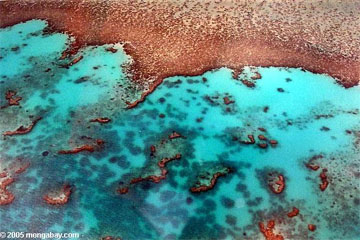Coral diseases largely result from human activities
Coral diseases largely result from human activities
mongabay.com
May 17, 2007
The apparent increase in infectious disease among coral is likely the result of environmental change and, as such, researchers should focus on understanding the relationship between coral diseases and environmental changes, rather than the diseases themselves, argues a paper published in the August 2007 issue of the Journal of Experimental Marine Biology and Ecology.
The paper, “Are infectious diseases really killing corals? Alternative interpretations of the experimental and ecological data”, is a response to recent academic papers that examine the emergence of disease in corals. The authors, led by marine biologist Michael P. Lesser of the University of New Hampshire, propose that “coral ‘diseases’, with rare exception, are opportunistic infections secondary to exposure to physiological stress (e.g. elevated temperature) that result in reduced host resistance and unchecked growth of bacteria normally benign and non-pathogenic.”

|
“These bacteria are from the environment, the host, or the coral mucus layer and become opportunistic pathogens,” they write.
While the authors do no advocate abandoning research on disease-causing organisms in corals, they believe “studies should include comprehensive efforts to better understand the relationship between coral diseases and environmental changes, largely anthropogenic in nature, occurring on coral reefs around the world.”
“These environmental insults are the cause of the physiological stress that subsequently leads to coral mortality and morbidity by many mechanisms including overwhelming infections by opportunistic pathogens.”
Scientists are concerned that climate change could dramatically impact coral reef ecosystems. Both increasingly levels of acidity, which reduce the ability of coral to generate their main structural material, and higher sea temperatures, which can cause “bleaching” or expulsion of the symbiotic algae that enable corals to feed, are cited as the primary risks to reefs in a world of higher atmospheric carbon dioxide levels. Some research suggests that as much as 95 percent of the corals on Australia’s Great Barrier Reef could die by 2050 should temperatures rise by 2 ocean temperatures increase by the 1.5 degrees Celsius projected by climate scientists. Despite the bleak outlook, it appears that some corals may be able to adjust to changing conditions. The end result is that reefs 50 years from now may be quite different than reefs of the present.
CITATION: Michael P. Lesser, at. al. (2007) Are infectious diseases really killing corals? Alternative interpretations of the experimental and ecological data. Journal of Experimental Marine Biology and Ecology Volume 346, Issues 1-2, 3 August 2007, Pages 36-44
“All climate models predict that this kind of ‘feedback’ will continue and intensify during this century. The Earth’s carbon sinks — of which the Southern Ocean accounts for 15% — absorb about half of all human carbon emissions. With the Southern Ocean reaching its saturation point more CO2 will stay in our atmosphere.”
The researchers note that since 1981 the Southern Ocean sink has effectively not increased its absorption of carbon dioxide, while global CO2 emissions increased by 40%.
They say their work suggests that stabilization of atmospheric CO2 will be even more difficult to achieve than previously believed. Scientists are concerned that such positive feedback loops between rising carbon dioxide emissions and carbon storage exist in other systems. For example, research published last month in Ecology Letters found that rainforest trees are storing less carbon as atmospheric carbon dioxide levels rise. Similarly, in the Amazon, higher temperatures may result in drier conditions that results in forests losing biomass, sending more carbon into the atmosphere.
The new Science also warns that ocean acidification in the Southern Ocean is “likely to reach dangerous levels earlier than the projected date of 2050.”
“Since the beginning of the industrial revolution the world’s oceans have absorbed about a quarter of the 500 gigatons of carbon emitted into the atmosphere by humans,” said Professor Chris Rapley, Director of British Antarctic Survey. “The possibility that in a warmer world the Southern Ocean — the strongest ocean sink – is weakening is a cause for concern.”
This article is based on a news release from the University of East Anglia